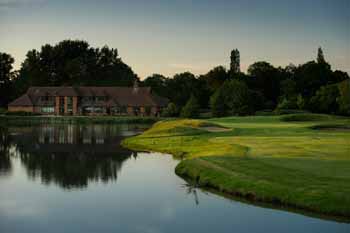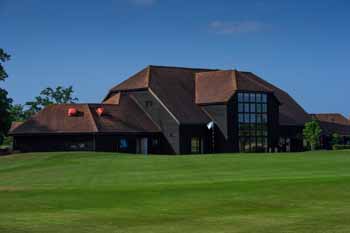Meet the golf charity: Get Golfing
Edward Richardson, a former England amateur golfer, has an extraordinary story to tell. Golf helped him overcome a severe illness, and this drove him to set up Get Golfing, a fast growing charity that turns around struggling golf clubs.
Can you tell us about the Get Golfing charity? How did it start, what are its aims and are these being achieved?
Around 2016 I was consulting with Aprirose, the owner of QHotels and much more, and decided I wanted to set up a charity that increased participation in golf.
The background to this was that 12 years ago, I had been extremely ill for a period of about three years. I know at first hand just how important physical exercise is for the brain but also the body. The stamina I had built up from playing so many rounds of golf a year stood me in good stead both when I was having treatment and during the long haul back to full health. It’s not just that it keeps you healthy, it also helps you recover after ill health.

Arkley Golf Club. Image by Chris Coles
So, around 2016, I saw that several leisure centre operators had come into the golf market and felt that there was also a place for a specialist charity to operate in the sector. With all due respect, I also felt that, in the same way I was not qualified to operate a leisure centre, they were not, perhaps, equipped to run a golf operation.
It was a time when the number of golf sites closing was increasing and I felt that, provided we could prove the concept, there was a real benefit to the game of golf if an operation like ours could run not only ex-municipal sites but also struggling member and proprietary venues.
In 2018, I was approached about Redlibbets Golf & Country Club near Sevenoaks in Kent. It had been built in the late 1990s, but it had not worked commercially, and plans were being made to close it.
I explained the vision behind Get Golfing (www.getgolfing.org) and was able to persuade the landlords to support us. Their decision to agree a commercial lease with us was the break we needed. Without the landlords’ faith and the trust in what we were proposing to do, we probably would never have got started.

Pyrford GC. All images in this page are by Andy Hiseman, unless stated otherwise
The turnaround has been beyond our expectations. We have been able to re-invest just short of £350,000 of cash surpluses back into the property. In that respect, the members, visitors, ourselves and the landlord have all benefited.
In the last three years Get Golfing has gone from being established to operating nine golf clubs. Could you take us through what has happened in those three years?
Having proved our model at Redlibbets, where the turnover has doubled to £1.5 million in two years, we have always been keen to look at other opportunities. We don’t have ambitions to build an empire but where there may be a need for us, and we may be able to make an impact, we will look at it.
Over Christmas 2019, Ian Simpson at Savills approached us about Warley Park in Essex. It was a 27-hole site on clay that had struggled under its previous operator. Thankfully, the owner had become a frequent customer of ours at Redlibbets, so we immediately hit it off and took over in March 2020.
At much the same time, we were approached by Ben Allen of HMH Leisure about six of Crown Golf’s sites. Crown had recently announced it was a property company and, as it was explained to us, it was looking to get out of golf. Credit to all concerned, we managed to pull off a six-site deal with one seller, one buyer and five landlords plus seven sets of lawyers during a pandemic!

Hampton Court Palace GC
The sites we acquired were tired and had failed to make a return for several years. They didn’t have property development prospects, so Crown was keen to move them on. To us, they were fundamentally good sites — in terms of the designs and demographics and so on — that had simply lost their way. We felt that by introducing some passion, changing some of the processes, and bringing our golf management experience to the party, we could turn them around.
Just prior to closing the deal, we got a great break when Jack Coleman decided to join us. Jack’s experience in food and beverage and clubhouse / property management enabled us to split the operations into two: golf experience and sales operations on one side; food and beverage and clubhouse customer experience on the other.
We feel as if we have started to make an impact but, in truth, with the surge of golf after the first lockdown and what is currently happening in 2021, I think it will be a while before we know if what we are doing works in the long term.

Mill Green GC
Each venue appears to require investment; how are you securing the funding for this?
Yes, they do! Don’t all sites? I am pretty sure that every club (private members’ or otherwise) would say that it rarely can invest what it needs to back into its property.
The sites we take on are generally neglected. Our challenge, much like any operator, is balancing investment and profitability. We don’t have bank loans, nor are we the beneficiary of any dowries, but we do have some tax breaks that separate us from proprietary operations and gives us some benefits such as those enjoyed by private members’ clubs.
We have no shareholders, so, apart from the need to retain sufficient working capital within the operation, we reinvest much of our profits back into our sites. Our 2020 audited accounts show profits of just under £1 million and we will have re-invested nearly £1.2 million during 2021. Our hope is that we can continue to generate healthy profits that can then be re-invested either in the existing sites or in new venues.
At Sherfield Oaks, close to Basingstoke, we have undertaken a complete renovation of the public areas of the clubhouse. We will then be moving on to the golf course and practice facilities in 2022 in what looks like will be a total redevelopment project over three to five years.
We have taken the opportunity at Pyrford Lakes to redesign the course using the existing routing and we are making upgrades to the drainage and irrigation systems.
The clubhouse and long-term landscaping of the site will follow.
Hampton Court Palace, like Sherfield, has seen its clubhouse refurbished and we have started a three-year programme to install fairway watering.
The irrigation to fairways will improve the playability of the course through the summer no end. Further improvements to the course with bunker renovations will follow in the coming years. In addition, we recently completed work on the practice ground, which has seen us build what we believe is the largest natural grass range tee in the London area.
Mill Green at Hertfordshire has also had its clubhouse refurbished and the course is going through renovations as we speak.

Hampton Court GC
Do you have plans to continue this expansion?
It is important to appreciate that Get Golfing is first and foremost a charity and its purpose is to promote participation in golf and the health benefits that come with it. In that context, we can’t think like a commercial operator. While we must be financially self-sufficient, our role is the betterment of golf at operator level. So, if a site comes up that we believe we can make better and encourage more people to play, we think we are duty bound to look at operating it. Recently, we were approached about two more sites and have agreed terms to operate the lovely James Braid-designed Arkley Golf Club near Barnet in Hertfordshire and the 27-hole Ansty Golf Centre near Coventry in the Midlands. Both have their challenges but we are looking forward to getting to know them and helping them fulfil their potential.
Clearly, we are not the only successful operator in the UK, there are many around the country. If, however, there is something we can do on our own or in collaboration with others that results in more people playing and enjoying the game, then this obviously meets our goals. Get Golfing was not established with the intention of empire building, it was simply a case of being in a position where we may fulfil a role.
We believe we offer landlords, golfers and local communities a viable economic alternative to closure or sale. Reverting to Redlibbets, its landlords now receive a return by way of rents that they were never able to make when operating the site themselves, and of course without the headache!

Arkley GC. Image by Chris Coles
Can you tell us about your own career to date?
Well, in terms of my playing career I represented England as an amateur golfer and had a fabulous time travelling the world in pursuit of a little white ball. After school in Kent, I went to university in America where I studied for degrees in economics and turf grass science. The latter was highly focused on the construction and maintenance of golf courses, and I have maintained a passion for delivering well-maintained courses since those early years.
In my business life, I have worked for ClubCorp, which is widely recognised as the finest operator of elite facilities around the world, also for Nicklaus Design, Trajectory Golf Design (Seve Ballesteros’s firm) and at Valderrama. All of these helped me learn the skills needed to operate successful clubs with established reputations.

Sherfield Oaks GC
What have your experiences of the pandemic been like in relation to these golf clubs from March 2020 until today?
It was either complete madness, with demand like we have never seen, or eerily quiet. When they could, people were playing golf as often as they could but then, when the tier system and other lockdown regulations came in, it was horrible to see the clubs devoid of people.
While the lockdowns were painful in terms of lost events and visitor income, we were able to get on with work that would otherwise have been highly disruptive to our members at a fair number of our sites. The time enabled us to formulate our operating procedures, carry out a substantial amount of staff training, and further brush up our sales and marketing.
Thanks to the fact that we are now slightly better established, it also allowed us to fund the recruitment of someone to begin the planning of our ‘Communities Development Operation’. This involves outreach programmes aimed at schools, nursing homes and other sections of our communities, who would not traditionally view golf establishments as welcoming places.
We are passionate about our sites’ place in their own communities. We want them to be a focal point not just for golf but for other charitable ventures and for people to socialise. If we were to have a mantra, it would be that golf courses are for the golfers, clubhouses are for everyone. Personally, I don’t like the term ‘clubhouse’, I think it puts non-golfers off from entering what is a multi-faceted leisure and entertainment venue. It is a place to eat and drink, socialise, relax, hold events from conferences to celebrations of all the stages of life to charity nights.
So, to further that aim, we have appointed a group development officer in Stuart Williams, whose role is to put together projects that benefit local communities via charities and institutions such as schools. He is responsible for ensuring that our core philosophy — that our sites are open and as inclusive for all — is realised.

Mill Green GC
Another core value for us is staff personal development. We are engaged, like many, with the government’s Kickstart programme to help individuals aged between 18 and 25 to get a foot on the career ladder.
I take a strong personal interest in this, and I want us to be able to offer hardworking, hungry and ambitious young people a platform to build their careers. During this year, we will have taken on more than 30 recruits to add to our staff of 250. Roles will range from on the course to inside the clubhouse and the goal is to help them find long-term employment, either with us or elsewhere in the industry. We are really keen for this programme to lead on to apprenticeships.
We have also started an internship programme for our green staff in association with Pelican’s Nest Golf Club, near Tampa in Florida. Four staff from across our group will benefit from a three-month training and life-experience programme with the highly experienced management of this 36-hole, Fazio-designed, private members’ club. Get Golfing will pay all their travel, accommodation, and wages during their internship. It may result in us losing staff to competitors, but we feel we will be contributing to the improvement of the whole industry.

Hampton Court Palace GC
What are your predictions for the UK golf industry over the next few years?
I think it is difficult to say. For us, as well as proprietary operators, the next few years offer opportunities, but no one really knows quite how they will manifest themselves. We know there will be more golfers, they will be younger, but we also know with certainty that they will have less disposable income.
The rump of the UK golf market (private members’ clubs) won’t change. They are run by members for members and, while not always efficient, serve the members, broadly speaking, well. What may be interesting to see is if those new to golf want to engage with that culture of captains’ parking spaces, no mobile phones and reserved tee times for the few.
What will also be interesting to see is the community-based initiative being championed by Martin Slumbers and The R&A at Lethamhill (Glasgow). It is a welcome change to see such direct support from our governing body. Such facilities are nothing new but the financial weight being placed behind this project means it will create traction. My fear is its long-term ability to be financially self-sufficient. Similar ventures by the likes of American Golf have been announced, so this can only be a positive thing for the game.

Sherfield Oaks GC
My one fear is what will happen to the small number of financially vulnerable members’ clubs and the standalone proprietary operations across the country. During the pandemic, there was a raft of support schemes from central and local bodies and The R&A, which, I suspect, have simply created a stay of execution for a few clubs. My fear is that these clubs won’t see their situation for what it is, and they will in time return to varying degrees of distress. Only time will tell.















I was a member of Mill Green golf club for 16 years, unfortunately I left with 14 other dissatisfied members because of the lack of professionalism from the general manager. In my opinion. He didn’t ask any of the members leaving at the time why we were leaving. We left because all the members facilities in the clubhouse were either taken down ( trophy winner’s boards) wiping away the history ( the heart) of the club. I personally had been a golf professional in my earlier life and a director in a prominent golf chain. Much to my surprise after leaving MG golf club 16 months ago, someone at MG is now ringing the ex members trying to convince them to rejoin their club! Well good luck with that! I will admit that the golf course has improved tremendously but as the ship is rudderless there is little chance of us all coming back!
We had exactly the same experience at Pyrford. Whilst they put a large investment to the club, it was done with zero communication with the members/committee (which they didn’t acknowledge).
The boards from the comps were slung in a skip, which was 30 years of history. There is a small core of 7 day members left, but a large number have gone elsewhere. Get Golfing made it quite clear they prefer society’s and pay as you play, rather than you bread and butter 7 day members.